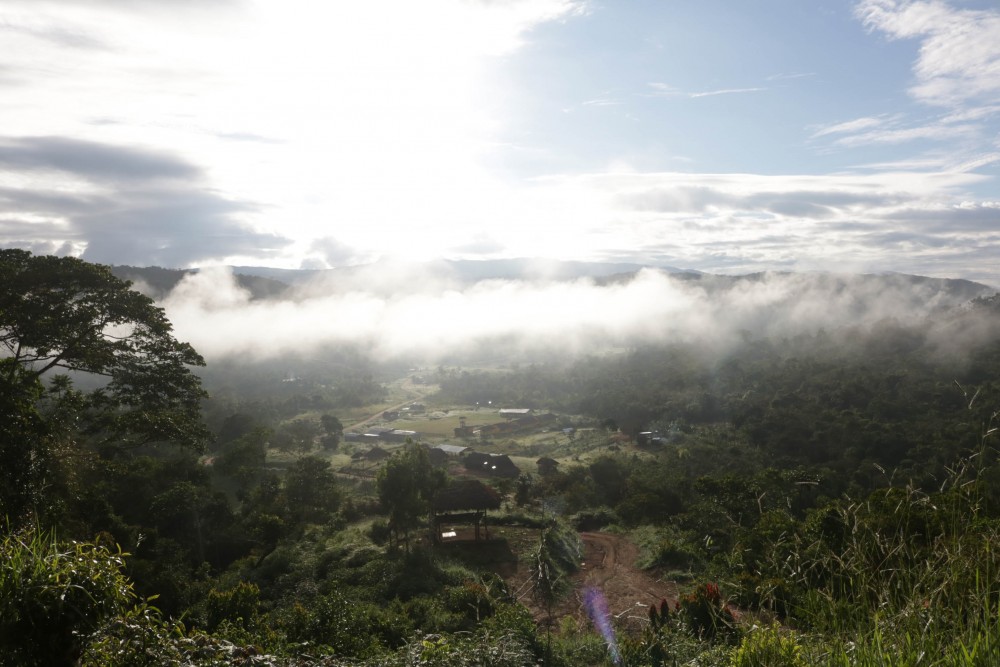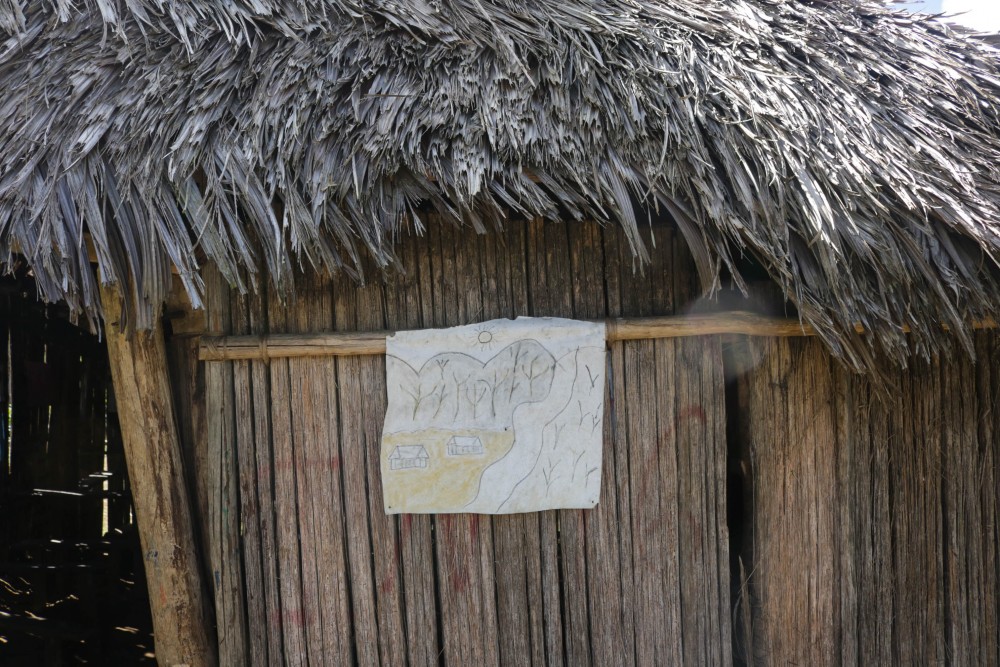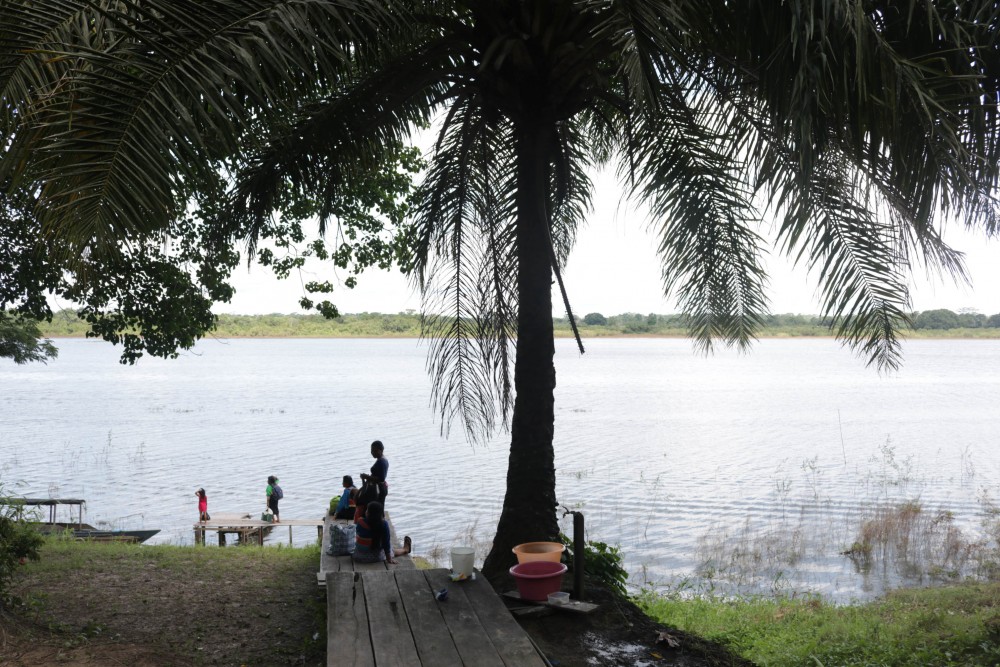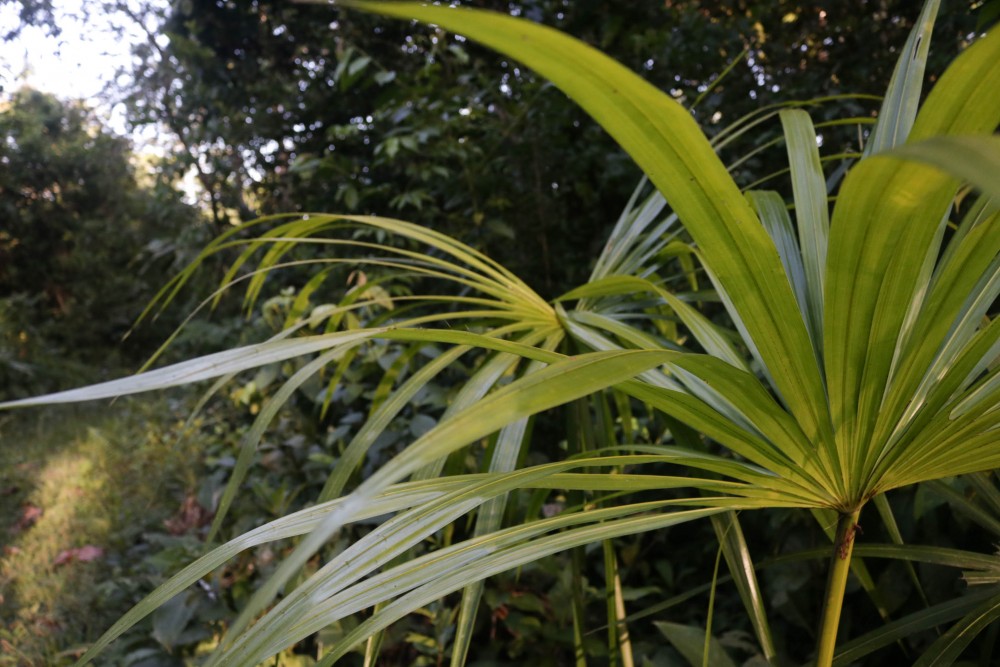Landbezit in de Peruaanse Amazone: Vooruitgang voor de inheemse bevolking of bron van conflict?
In Atalaya, een provincie in het Peruaanse Amazonegebied, wonen meer dan tweehonderd inheemse gemeenschappen van verschillende volkeren, waaronder de Asháninka. In augustus 2018 organiseerden zij een paro amazonico of een ‘staking van de Amazone’, waarbij ze tien dagen lang rivieren en wegen blokkeerden. Op die manier wilden ze de overheid dwingen om te voldoen aan de eisen van de hedendaagse inheemse Amazonegemeenschappen. Een van de voornaamste eisen is de bescherming van hun territoriale rechten.

Inheemse landrechten
Atalaya is een plek met een 'uitzonderlijke' geschiedenis. Tot de jaren 1980 werd de inheemse Asháninka-bevolking hier gedwongen tot slavernij voor koloniale patrónes. Die periode kwam tot een eind toen de bevolking zich in gemeenschappen verenigde en met de hulp van inheemse organisaties de rechten over hun land terugeisten. Deze beweging om de controle over hun voorouderlijke gronden te heroveren, is vandaag nog steeds bezig. Dit is een levensbelangrijke strijd, want de inheemse identiteit is sterk verbonden met hun territorium.
De meerderheid van de inheemse gemeenschappen in Atalaya heeft nog steeds geen landzekerheid. Hun territoriale rechten worden herhaaldelijk met de voeten getreden.
In deze context verbleef ik vier maanden voor onderzoek.

Autonomie?
Inheemse organisaties, die zichzelf federaties noemen, pleiten voor dekolonisatie (het beëindigen van ongelijke structuren die werden opgezet tijdens de kolonisatie en vandaag nog doorwerken) door middel van ‘inheemse autonomie’. Het recupereren van voorouderlijke territoria is voor hen een noodzakelijke voorwaarde voor het overleven van inheemse culturen. Het bekomen van inheemse landeigendomstitels, waarbij een gemeenschap het land bezit, is hierbij de eerste stap. Toch is dit niet voldoende. Uit de vele conflicten en moeilijkheden blijkt dat eigendomstitels geen garantie zijn voor territoriale veiligheid. Landstitels komen met vele beperkingen. Zo blijven grondstoffen, water en bos onder staatscontrole, en krijgt de Asháninka-gemeenschap hier enkel gebruiksrecht over. Van inheemse autonomie is dus geen sprake. Daarnaast zijn landstitels vaak onvolledig, waardoor er overlappingen tussen verschillende gemeenschappen en andere betrokkenen zijn, wat tot landconflicten leidt. Gaten in de wet, alomtegenwoordige corruptie en anti-inheems racisme zorgen ervoor dat inheemse landrechten geen prioriteit zijn.
Landtekort
Asháninka gemeenschappen leven van de jacht en ‘verschuivende landbouw’. Hiervoor hebben zij een groot terrein nodig. Landstitels zijn doorgaans te klein. Wanneer een gemeenschap groeit, heeft zij ook meer grond nodig. Doordat er steeds meer mensen van buitenaf zich in de regio vestigen – waaronder vele grootgrondbezitters – is er geen plek voor uitbreiding. Bovendien maken sommigen misbruik van de wet, door zich als ‘inheems’ voor te doen om op die manier grond te bemachtigen, die dan illegaal wordt doorverkocht. Dit zorgt voor wantrouwen tegenover inheemse gemeenschappen, en leidt ertoe dat er geen land overblijft voor (echte) nieuwe gemeenschappen.
Economische belangen versus inheemse rechten
Hoewel inheemse volkeren hier lang voor de kolonisatie en de stichting van de moderne Peruaanse staat woonden, worden hun landrechten openlijk in twijfel getrokken. De overheid stelt economische winst als prioriteit, en geeft voorrang aan industrie (zoals houtkap en mijnbouw). Terwijl gemeenschappen decennia wachten op een eigendomsbewijs, krijgen ondernemers en bedrijven binnen enkele maanden een concessie. Inheems landgebruik, waarbij gewerkt wordt voor levensonderhoud en niet voor commerciële doeleinden, wordt als ‘onproductief’ beschouwd. Een houtbaron drukte het zo uit: “De ‘indiaan’ werkt niet maar profiteert”. Deze zelfde man wordt ironisch genoeg verantwoordelijk geacht voor het uitbuiten van inheemse families.
Een levend territorium
Het geloof dat inheemse gemeenschappen hun grond niet gebruiken heeft deels zijn oorsprong in racisme, maar eveneens in de dominantie van het kapitalisme en het onbegrip voor andere wereldbeelden. De inheemse visie van land en territorium is namelijk heel anders dan de visie van de moderne staat. Deze laatste baseert zich op het Westerse, kapitalistische kader, voortbouwend op koloniale ideeën. Bij de kolonisatie waren kolonisatoren ervan overtuigd dat ze het land beter benutten dan de inheemse bevolking – terwijl ze in werkelijkheid niet openstonden voor alternatieve levenswijzen en kennis, waar ze wel wat van konden leren. In het kapitalistische systeem worden mens en natuur kunstmatig gescheiden van elkaar (‘Natuur/Cultuur’) en wordt de natuur gezien als een voorraad grondstoffen, voor menselijk gebruik. Land wordt hierdoor een (levenloos) economisch waar.

Inheemse volkeren maken geen opsplitsing tussen Natuur/Cultuur en zien zichzelf als deel van hun omgeving, binnen een geheel van menselijke en niet-menselijke actoren (plant, dier, water, lucht, geesten en voorouders), die allen verbonden zijn. Hun relatie met hun land – deel van een ‘multidimensionaal territorium’ – is naast economisch ook spiritueel en ecologisch. De aarde en het territorium worden als levend beschouwd. Asháninka leider Bernardo Silva, door iedereen Tyontyori of egel genoemd, vertelde me:
“De aarde is als een moeder die ons voedt. We zaaien en zij produceert. Ze geeft ons medicijn, bladeren voor onze huizen. Ze houdt van ons, geneest en voedt ons. Ze geeft ons alles, en wanneer we sterven gaan we terug naar haar. [Hij neemt een pauze en voegt er lachend aan toe:] Zoals ik mijn kippen voed om hen later op te eten.”
Naar de toekomst toe
Binnen het kapitalistische systeem zien mensen hun leefwijze doorgaan als de norm, of zelfs als enige optie. Veel inheemse culturen zijn daarin anders; zij accepteren het bestaan van verschillende realiteiten naast elkaar. We noemen dit ‘pluriverseel’. Waar de (kapitalistische) staat een ‘universum’ ziet, zien inheemse culturen een ‘pluriversum’, waarin bijvoorbeeld Westerse en inheemse elementen samen voorkomen.
De institutie van landstitels volgt exclusief de kapitalistische visie op land: als bezit. In de zoektocht naar dekoloniale strategieën kunnen oplossingen echter niet uit ditzelfde kader (met koloniale oorsprong) komen. Ik argumenteer dat het inheemse ‘pluriversum’ ons hierbij kan gidsen. Dit leert ons een openheid naar andere culturen en creëert ruimte voor de ontmoeting van wereldbeelden en verschillende soorten kennis, die elkaar aanvullen. Met het oog op de huidige ecologische crisis, is dit niet alleen noodzakelijk in Peru, maar ook hier in Europa.
Om onze relatie met onze leefomgeving te herstellen moeten we ideeën over land en bezit herdenken, en beseffen dat wij als mens deel uitmaken van een complex geheel van menselijke en niet-menselijke elementen. Inheemse wijsheden leren ons onze vervreemding van de natuur te overkomen.

Bibliografie
Acuña, R. M. (2015). The politics of extractive governance: Indigenous peoples and socio-environmental conflicts. Extractive Industries and Society 2(1), 85—92.
AIDESEP. (2018, August 16). Atalaya: miles de indígenas exigen soluciones y trato con Presidente Vizcarra. Retrieved from http://www.aidesep.org.pe/index.php/noticias/atalaya-miles-de-indigenas-exigen-soluciones-y-trato-con-presidente-vizcarra. Accessed June 3, 2020.
AIDESEP. (2019, July 23). AIDESEP y Presidente Vizcarra se reúnen para asegurar titulación de todas las comunidades indígenas para antes del 2021. Retrieved from http://www.aidesep.org.pe/noticias/aidesep-y-presidente-vizcarra-se-reunen-para-asegurar-titulacion-de-todas-las-comunidades. Accessed June 9, 2020.
AIDESEP. (2020). Qué Queremos. Retrieved from http://www.aidesep.org.pe/que-queremos-interno. Accessed April 15, 2020.
Alfred, T., & Corntassel, J. (2005). Being Indigenous: Resurgences against contemporary colonialism. Government and opposition 40(4), 597-614.
Amin, S. (1974). Accumulation on a World Scale. A critique of the theory of Underdevelopment. New York: Monthly Review Press.
Anthias, P., & Radcliffe, S. A. (2015). The ethno-environmental fix and its limits: Indigenous land titling and the production of not-quite-neoliberal natures in Bolivia. Geoforum 64, 257-269.
Barletti, J. P. Sarmiento (2016). La comunidad en los tiempos de la Comunidad: bienestar en las Comunidades Nativas asháninkas. Bulletin de l'Institut français d'études andines 45(1), 157-172.
Bhandar, B. (2018). Colonial Lives of Property: Law, Land, and Racial Regimes of Ownership. London, UK: Duke University Press.
Blaser, M., & de la Cadena, M. (2018). A world of many worlds. Durham, NC: Duke University Press.
Blomley N. (2014). Making space for property. Annals of the Association of American Geographers 104(6), 1291-1306.
Brown, J. E. (1982). The spiritual legacy of the American Indian. New York: Crossroad.
Buhner, S. H. (2004). The secret teachings of plants: The intelligence of the heart in the direct perception of nature. Rochester: Inner Traditions/Bear & Co.
Burneo Mendoza, R. (2018). Territorio Integral Indígena, una propuesta awajún. Iztapalapa. Revista de ciencias sociales y humanidades 39(85), 33-57.
Camero, P., & Gonzales, I. (2018). Cartilla No. 3: Los pueblos indígenas y los procesos de reconocimiento y titulación de comunidades nativas. Serie: Derechos de los Pueblos Indígenas en el Perú. Lima: DAR-GIZ.
Campanera Reig, M. (2012). ¿ Campesina o Nativa? Derecho, política e identidad en los procesos de titulación de comunidades en la Amazonía Peruana. Quaderns-e de l'Institut Català d'Antropologia 17(1), 10-24.
Chirif, A., & Hierro, P. G. (2007). Marcando territorio: progresos y limitaciones de la titulación de territorios indígenas en la Amazonía. Copenhague, Denmark: International Work Group for Indigenous Affairs (IWGIA).
Chirif, A., Hierro, P. G., & Chase Smith, R. (1991). El indígena y su territorio son uno solo.-Estrategias para la defensa de los pueblos y territorios indígenas en la cuenca amazónica. Lima, Peru: Oxfam América; Iquitos, Peru: COICA.
Cottyn, H. (2014). Renegotiating communal autonomy: communal land rights and liberal land reform on the Bolivian altiplano: Carangas, 1860-1930. Doctoral dissertation, Ghent University.
CORPIAA. (2017). Plan Estratégico Institucional: Coordinadora Regional de Pueblos Indígenas de AIDESEP Atalaya 2017-2021. Working plan.
Cronkleton P., & Larson, A. (2015) Formalization and Collective Appropriation of Space on Forest Frontiers: Comparing Communal and Individual Property Systems in the Peruvian and Ecuadoran Amazon. Society & Natural Resources 28(5), 496-512.
Cusicanqui, S. R. (2012). Ch'ixinakax utxiwa: A Reflection on the Practices and Discourses of Decolonization. South Atlantic Quarterly 111(1), 95-109.
De la Cadena, M. (2015). Earth beings: Ecologies of practice across Andean worlds. Durham, NC: Duke University Press.
Delgado-P., G. (2009). Bordering Indigeneities: Two Notes on Decolonization and Sp/l/ace. UC Davis: Indigenous Research Center of the Americas. Retrieved from https://irca.ucdavis.edu/en/bordering-indigeneities-two-notes-decolonization-and-splace. Accessed March 9, 2020.
Duncan, C. R. (2004). Civilizing the margins, Southeast Asian Government policies for the development of minorities. Ithaca: Cornell University Press.
Escobar, A. (2017). Sustaining the pluriverse: The political ontology of territorial struggles in Latin America. In Brightman, M., & Lewis, J. (Eds.). The anthropology of sustainability: beyond development and progress. New York, NY: Palgrave Macmillan, New York.
Espinosa, Ó. (2010). Cambios y continuidades en la percepción y demandas indígenas sobre el territorio en la Amazonía peruana. Anthropologica del Departamento de Ciencias Sociales 28(28), 239-262.
FABU. (2018). Plan Estratégico de la Federación Asháninka del Bajo Urubamba. Working plan.
Fanon, F. (2008). Black skin, white masks (1952). London: Pluto Press.
FECONAPA. (2019). Plan Estrátegico 2019-2024. Working plan.
Hierro, P. G., Hvalkof, S., & Gray, A. (1998). Liberation through land rights in the Peruvian Amazon. Copenhague, Denmark: IWGIA.
Greaves, W. (2018). Damaging Environments: Land, Settler Colonialism, and Security for Indigenous Peoples. Environment and Society 9(1), 107-124.
Guzmán, T. D. (2013). Native and National in Brazil: Indigeneity after Independence. Chapel Hill, NC: UNC Press Books.
Harvey, G. (2017). Animism: Respecting the living world. London: C. Hurst & Co Publishers Ltd.
Herrera, L.C. (2019, October 24). Moira Millán, lideresa mapuche: La lucha no debe ser contra el “cambio climático” sino contra el terricidio. NODAL. Retrieved from https://www.nodal.am/2019/10/moira-millan-lideresa-mapuche-la-lucha-no-debe-ser-contra-el-cambio-climatico-sino-contra-el-terricidio/. Accessed March 9, 2020.
Hirtz, F. (2003). It takes modern means to be traditional: On recognizing Indigenous cultural communities in the Philippines. Development and Change 34(5), 887-914.
Hvalkof, S. (2008). Colonization and Conflict on the Amazon Frontier: Dimensions of Interethnic Relations in the Peruvian Montaña. In Geiger, D. (2008). Frontier Encounters-Indigenous Communities and Settlers in Asia and Latin America, 219-286. University of Zurich.
Ince, O. U. (2018). Colonial capitalism and the dilemmas of liberalism. Oxford University Press.
Jenkins, J.J. (2012). A neonative ecozoic wisdom: Interfacing indigenous cosmological ritual and the universe story. California Institute of Integral Studies.
Killick, E. (2008). Creating community: land titling, education and settlement formation amongst the Ashéninka of Peruvian Amazonia. Journal of Latin American and Caribbean Anthropology 13(1), 22-47.
Lâm, M. C. (2004). Remembering the country of their birth: Indigenous peoples and territoriality. Journal of International Affairs 57(2), 129-150.
Larson, A. M., Monterroso, I., & Cronkleton, P. (2018). Collective titling in the Peruvian Amazon: A history in three acts. Center for International Forestry Research (CIFOR).
Law, J. (2015). What's wrong with a one-world world?. Distinktion: Scandinavian Journal of Social Theory 16(1), 126-139.
Li, T. M. (2014). What is land? Assembling a resource for global investment. Transactions of the Institute of British Geographers 39(4), 589-602.
Li, T. M. (2014). Land's End: capitalist relations on an Indigenous frontier. Duke University Press.
Li, T. M. (2010). Indigeneity, Capitalism, and the Management of Dispossession. Current Anthropology 51(3), 385-414.
Liffman, P. (1998). Indigenous territorialities in Mexico and Colombia. Cultural Environments and Development Debates: Latin America.
Locke, J. (2014). Second treatise on civil government (1690). New York, NY: Spark Publishing.
Lorde, A. (1984). The Master’s Tools Will Never Dismantle the Master’s House. In Sister Outsider: Essays and Speeches, 110-114. Berkeley, CA: Crossing Press.
Lovelock, J. (1979). Gaia: a new look at life on earth. Oxford: Oxford University Press.
Maezumi, S.Y., Alves, D., Robinson, M. et al. (2018). The legacy of 4,500 years of polyculture agroforestry in the eastern Amazon. Nature Plants 4: 540–547.
Mamdani, M. (2012). Define and rule: Native as political identity. Harvard University Press.
Marx, K. 1981. Capital: a critique of political economy, Volume I. Harmondsworth: Penguin.
Mignolo, D. Walter. (2005). La colonialidad a lo largo y a lo ancho: el hemisferio occidental
en el horizonte colonial de la modernidad. In Lander E. La colonialidad del saber: eurocentrismo y ciencias sociales. Perspectivas Latinoamericanas. Buenos Aires: Clacso.
Mitchell, T. (Ed.). (2000). Questions of modernity. University of Minnesota Press.
Mohanty, S. P. (1995). Epilogue. Colonial legacies, multicultural futures: relativism, objectivity, and the challenge of otherness. Publications of the Modern Language Association of America 110(1), 108-118.
Monterroso, I., Cronkleton, P., Pinedo, D., & Larson, A. M. (2017). Reclaiming collective rights: land and forest tenure reforms in Peru (1960-2016). CIFOR.
Narby, J. (1989). Visions of Land: The Ashaninca and Resource Development in the Pichis Valley in the Peruvian Central Jungle. Doctoral dissertation, Stanford University.
OIRA. (2016). Programa del Plan Operativo 2016-2020. Working plan.
Orta-Martínez, M., & Finer, M. (2010). Oil frontiers and Indigenous resistance in the Peruvian Amazon. Ecological Economics 70(2), 207-218.
Polanyi, K. (1944). The great transformation: The political and economic origins of our time. Boston, MA: Beacon Press.
Praeli, Y. S. (2018, December 21). Land Trafficking in Peru: Officials Arrested for Falsifying Documents. Mongabay Environmental News. Retrieved from https://news.mongabay.com/2018/12/land-trafficking-in-peru-officials-arrested-for-falsifying-documents/. Accessed January 9, 2020.
Quijano, A. (2007). Coloniality and modernity/rationality. Cultural studies 21(2-3), 168-178.
Rasmussen, M. B., & Lund, C. (2018). Reconfiguring Frontier Spaces: The territorialization of resource control. World Development 101, 388-399.
Ramos, A. R. (2006). The Commodification of the Indian. In Posey, D. A., & Balick, M. J. (Eds.). Human impacts on Amazonia: the role of traditional ecological knowledge in conservation and development. Columbia University Press.
Ross, Alexandre Reid. (Ed). (2014). Grabbing Back. Essays Against the Global Land Grab. Berkeley: AK Press.
Rutazibwa, O. (2019, February 13). Nice to Meet You: Olivia Rutazibwa. Opera Forward Festival. Retrieved from https://operaforwardfestival.nl/nieuws/olivia-rutazibwa-diversiteit-voorbij-etalage/. Accessed July 17, 2020.
Santos‐Granero, F., & Barclay, F. (2011). Bundles, stampers, and flying gringos: Native perceptions of capitalist violence in Peruvian Amazonia. The Journal of Latin American and Caribbean Anthropology 16(1), 143-167.
Scott, J. C. (1998). Seeing like a state. New Haven (Conn.): Yale University Press.
Sletto, B. (2009). Indigenous people don't have boundaries: reborderings, fire management, and productions of authenticities in indigenous landscapes. Cultural geographies 16(2), 253-277.
Smith, L. T. (1999). Decolonizing Methodologies: Research and Indigenous Peoples. London: Zed.
Smith, R. C., Benavides, M., Pariona, M., & Tuesta, E. (2003). Mapping the past and the future: Geomatics and indigenous territories in the Peruvian Amazon. Human Organization 62(4), 357-368.
Sponsel, L. E. (Ed.). (1995). Indigenous peoples and the future of Amazonia: An ecological anthropology of an endangered world. Tucson: University of Arizona Press.
Sax, S. (2019): Invisible territory: mapping land-use change and power in the Peruvian Amazon. Journal of Land Use Science 15(2-3), 290-305.
Shiva, V. (1995). Monocultures of the Mind. Perspectives on Biodiversity and Biotechnology. London: Zed Books.
SPDA Actualidad Ambiental. (2018, August 28). Paro indígena: ¿Cuáles son las demandas de los pueblos indígenas de Atalaya (Ucayali)? SPDA Actualidad Ambiental. Retrieved from https://www.actualidadambiental.pe/paro-indigena-cuales-son-las-demandas-de-los-pueblos-indigenas-de-atalaya-ucayali/. Accessed March 8, 2020.
Suler, A. (2020). Land as Medicine. Course: Intuitive Plant Medicine. One Willow Apothecaries. Retrieved from https://onewillowapothecaries.com/. Accessed July 17, 2020.
Sullivan, L. (2013). Identity, territory and land conflict in Brazil. Development and Change 44(2), 451-471.
Surrallés, A., & Hierro, P. G. (Eds.). (2004). Tierra adentro: Territorio indígena y percepción del entorno. Copenhague, Denmark: IWGIA.
Tavares, P. (2016). Over the Ruins of Amazonia: colonial violence and decolonial resistance at the frontiers of climate change. Doctoral dissertation, University of London.
Tomiak, J. (2017). Contesting the settler city: Indigenous self‐determination, new urban reserves, and the neoliberalization of colonialism. Antipode 49(4), 928-945.
Tsing, A. L. (2011). Friction: An ethnography of global connection. Princeton University Press.
Tuck, E., & Yang, K. W. (2012). Decolonization is not a metaphor. Decolonization: Indigeneity, education & society 1(1), 1-40.
URPIA. (2019). Plan de Trabajo Febrero, 2019 a Febrero, 2020. Working plan.
Varese, S. (2017). Velasquismo in Amazonia, 1968-1975. In Aguirre, C., & Driot, P. (Eds.). The peculiar revolution: rethinking the Peruvian experiment under military rule. Austin, Texas: University of Texas Press.
Vaughan-Lee, L. (Ed.) (2017). Spiritual ecology: The cry of the earth. Point Reyes: The Golden Sufi Centre.
Wallerstein, I. (2012). Land, space, and people: constraints of the capitalist world-economy. Journal of World-Systems Research 18(1), 6-14.
Warren, C. A. B. (2002). Qualitative interviewing. In Gubrium J. F. & Holstein J. A. (eds.). Handbook of interview research: Context and method, 83-101. Sage Publications.
Wolfe, P. (2006). Settler colonialism and the elimination of the native. Journal of Genocide Research 8(4), 387-409.
World Bank. (2018). World Bank Integrated Forest Landscape Management Project in Atalaya, Ucayali. Retrieved from http://documents.worldbank.org/curated/en/716521546916448982/Peru-Integrated-Forest-Landscape-Management-Project-in-Atalaya-Ucayali. Accessed March 8, 2020.
Yilmaz, K. 2013. Comparison of quantitative and qualitative research traditions: Epistemological, theoretical, and methodological differences. European Journal of Education 48(2), 311-325.










